By TCN News,
New Delhi: A fact finding report by Jawaharlal University Students’ Union (JNUSU) has alleged that the riot was preplanned and institutionalized with the complicity of the police.
The JNUSU fact finding team visited Muzaffarnagar and its surrounding riot affected villages on September 21 and 22 with “the objective of presenting a clear and categorical report of the riots and to consider ways in which the JNUSU and wider society can intervene in this situation.” The team comprised 10 members- JNUSU President Akbar Chaudary, Vice President Anubhuti Agnes Bara, Abdul Matin, Chetan, Shadab, Hina Goswami, Fakruzzaman, Alvi, Imtiaz.
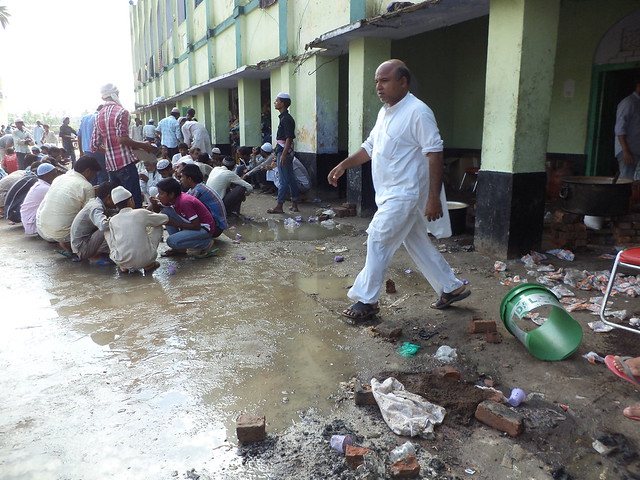
A view of relief camp.
They pointed out that the bewildered Muslims of Kawaal are unable to reconcile shrill accusations of being the beneficiaries of “appeasement” by the Samajwadi Party, with their everyday reality of living in their own villages under the protection of the Provincial Armed Constabulary (PAC).
Highlighting the sinister vitiating of atmosphere by the VHP, which tried to resurrect the old bogey of “love jihad” which it has earlier tried unsuccessfully in Kerala. “It has tried to play upon the patriarchal common sense that women, especially young girls are vulnerable, and easily beguiled by Muslim youth, who, rather conveniently, being unemployed have all the time,” the report pointed out.
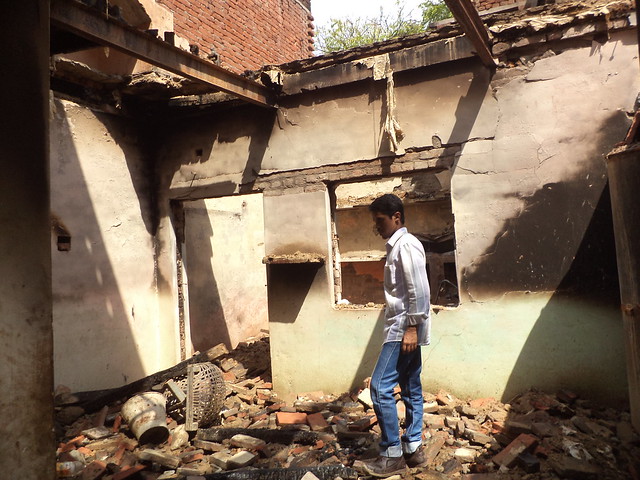
Burnt house at Lisad village of Shamli dist.
Despite the hype, one police officer that the fact finding team spoke to in the thana Shahpur said that the actual number of complaints filed of sexual harassment were not in proportion with this perception of an all-out attempt to harass Jat women, it further added.
While it is clear that the incident at Kawaal merely provided a pretext for political entrepreneurs from all sides to fish in troubled waters the local police is yet to conclude its investigation into the killings two weeks after they happened. What is worse the police have not even come up with its version of events based on the current stage of the investigation.

Masjid in Lisad.
The report has also questioned the role of the political parties, including BSP, SP and BJP for “fishing in troubled water.”
Given that Muslim victims have chosen other villages with a substantial Muslim population, and with prospects of returning to their villages a process of ‘forced ghettoization’ is under way, the report further observed.

View of camp at Kandla.
JNUSU has demanded that the Anti-Communal Violence Bill be tabled immediately in the Parliament and that “mixed police stations” are promoted, besides fixing clear accountability in riot cases.
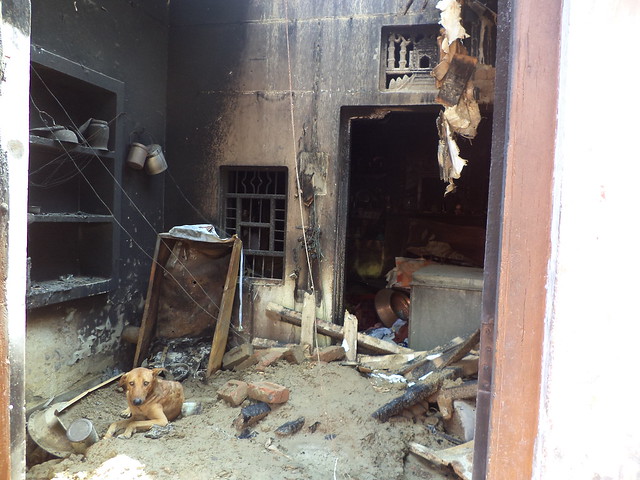
Full Report:
Institutionalized Riots, Transfer Raj and Complicit Police: A tale of Indian Democracy.

21st and 22nd September 2013
Introduction:
The communal riots that tore through Muzaffarnagar from the 6th to the 13th of September were unprecedented in its history. Total number of deaths, according to official records, is 49 with at least 37 Muslims and 6 Jats losing their lives. The riots bring into question democratic practices and the role of political parties in Uttar Pradesh. While political parties have cynically sought to engineer social divisions between the Jats and the Muslims, local officials too have displayed little stakes in maintaining the credibility of the local police and the administration. In effect, despite tall claims of social inclusion the unholy nexus between an opportunist polity, a compromised police and the media, working together in an “institutionalized riot system” has furthered the marginalization and disempowerment of socially and economically weaker sections of Muzaffarnagar and its surrounding villages. In this context the JNUSU fact finding team visited Muzaffarnagar and its surrounding riot affected villages with the objective of presenting a clear and categorical report of the riots and to consider ways in which the JNUSU and wider society can intervene in this situation. The team comprised 10 members- JNUSU President Akbar Chaudary, Vice President Anubhuti Agnes Bara, Abdul Matin, Chetan, Shadab, Hina Goswami, Fakruzzaman, Alvi, Imtiaz.
Bewildered Muslims of Kawaal are unable to reconcile shrill accusations of being the beneficiaries of “appeasement” by the Samajwadi Party- in their case of personal intervention by Parliamentary Affairs Minister Azam Khan to influence the police investigation into the Kawaal killings of Shahnawaz, Sachin and Gaurav – with their everyday reality of living in their own villages under the protection of the Provincial Armed Constabulary (PAC). Local Jats who complain of police partiality into the investigation fail to see that Kawaal’s Muslims themselves never asked for this infamous “phone call”, or see how Azam Khan’s lame gesture of transferring the DM Surendra Singh and the SSP Manzil Saini on the 28th August was matched by the SPs gesture of keeping the local police from enforcing section 144 in the run up to the 7th September mahapanchayath. The PAC, other units of the Army were particularly asked by the DM not to use their weapons, even as the DM failed to issue orders sealing Muzaffarnagar and Kawaal to the thousands gathering at the mahapanchayath.
Bhisham Singh, Gaurav’s father, while raising the wholly justified demand for an impartial inquiry into the killing of his son, also appealed against retaliatory acts of revenge. Bhisham Singh’s appeal mattered little as political entrepreneurs hijacked anger against the administration for political gains. The orchestrated nature of the riots is most evident in BJP MLA from Sardhana Sangeet Som’s brazen attempts to fan communal tensions by circulating a fake video, allegedly of a Muslim mob lynching Sachin and Gaurav on the 27th.

(Mahapanchayath on the 7th September at the Sikhera village. Attended by close to 1.5 lakh people from Haryana, delhi and UP. BJP MLA Sangeet Som openly incited violence, and some members brandished swords. Photo: First Post)
The “bahu, beti samman bacho mahapanchayath” was attended by close to 1.5 lakh people from UP, Haryana, and Delhi. Police partiality into the investigations proved merely an excuse for organizing the rally which saw thinly veiled calls to violence and for the BJP’s Prime Ministerial aspirant Narendra Modi to save the honour of Jat “bahu aur beti”(check). Matters worsened when people attending the mahapanchayath started returning to their villages when at one point they were attacked at the Basee village. This attack, allegedly by a Muslim mob, led to the death of two Jats returning from the mahapanchayath. These killings apparently led to a backlash and the conflagration spread as other Jats returning to their villages started attacking the Muslim population in their village.
The total number of deaths, according to official reports, is 49 with atleast 37 Muslims and 6 Jats dead. The number of dead may go up significantly as the police begin investigating cases of missing villagers. The local police is bogged down in the immediate task of maintaining law and order, and all investigations have suffered as a result, including investigations into the crucial cases of Kawaal and Basee.
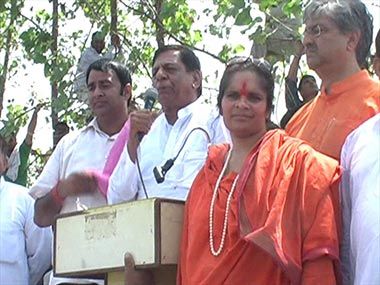
(BJP MLA Sangeet som and Sadhvi Prachi on the dias of the mahapanchayath. The assembled crowd chased down and killed Israr Vakeel, who was a photographer for a news network. Photo: First Post.)
Fact finding team’s visit to Kawaal village:
Kawaal village lies on the route from Mallikpura to Nangra Manduad, where the Inter College which Gaurav and his sister used to attend is situated. Mallikpura is a predominantly Jat village of about 15-20 families and is separated from Kawaal by about 2 kilometers. Kawaal is a predominantly Muslim village. The teenager in question had to cycle her way from Mallikpura to Kawaal where she parked her cycle, from where she would either take the bus or a 20 minute walk to the college.
The JNUSU team spoke with the father of Shahnawaz, and the parents of Sachin and Gaurav about the killings on the 27th September. Shahnawaz’s father, Mr.Saleem, is a farm laborer (check) in Kawaal. He insisted that Shahnawaz was not involved in any eve-teasing incident as alleged by the family of Sachin and Gaurav. He argued that while it is highly improbable that Shahnawaz would misbehave with the girl in a public square, even if such were the case why could both Sachin and Gaurav file a complaint with the village panchayath or raise the issue with him. “Agar ladki ched raha tha toh mar dete kya usko?” he asked.
Mr.Saleem then went on to counter allegations that Shahnawaz had been harassing the teen aged girl for about three months now. He pointed out that Shahnawaz worked as a factory worker in a textile mill in Chennai. Shahnawaz had come back home just a month prior to his death on the 27th August to check on his cousin who had suffered an accident.
The VHP has tried to resurrect the old bogey of “love jihad” which it has earlier tried unsuccessfully in Kerala. It has tried to play upon the patriarchal common sense that women, especially young girls are vulnerable, and easily beguiled by Muslim youth, who, rather conveniently, being unemployed have all the time. Despite the hype, one police officer that the fact finding team spoke to in the thana Shahpur said that the actual number of complaints filed of sexual harassment were not in proportion with this perception of an all out attempt to harass Jat women.
Presenting a completely different narration of events, Mr.Saleem said that it was a motor bike accident, preceded by a verbal argument the day before, that led to the attacks on Shahnawaz. Shahnawaz was returning on a motor bike when he ran into Gaurav and Sachin on another bike. The latter challenged him to wait there and left. While Shahnawaz returned home then he was apprehended by the duo and others when he again left home to get some medicines for his mother and killed. The crowd that had gathered around got hold of both Sachin and Gaurav in the melee and lynched them.
The FIR filed into the investigation also refers to the motorbike incident as the cause of the killings, though the Jats allege that the FIR filed by an SSP appointed hours after the transfer of the previous SSP Manzil Saini is bound to be politically motivated.
Mr.Saleem and the rest of Shahnawaz’s family fled Kawaal village on the 28th fearing retaliatory violence. While Mr.Saleem has since returned his family, he told is still in Chennai. When the JNUSU fact finding team visited his home he was escorted by a clutch of policemen. During our interaction with him, the policemen kept insisting that he bring his family back. “Kab tak gharwalon ko kahi aur rakhoge?….gaon wale appaas mein baith ke sulah kara denge aap logon ke… ” he said. (For how long will you keep you family away from their home…the villagers will sit together and bring about a truce.) Mr. Saleem himself remained unpursuaded.
Sachin and Gaurav’s family members in Mallikpura contested Mr. Saleem’s version of events. “Quraishi ke ladke chedkhani karte the hamari ladki ke saath…” they alleged, and made no reference to any motorcycle accident. While the fact finding team could not meet with the teen aged girl whose alleged harassment set of the killings, she has since alleged that she was harassed repeatedly for a number of months. When the CM Akhilesh Yadav visited her family members she reportedly handed him a letter asking him to construct a direct road linking Mallikpura to her college in Nangra Manduad. The family also alleged that Qadir Rana, the BSP MLA from Muzaffarnagar and Rashid Siddiqui, Samajwadi Party leader tried to influence the police investigation.
While it is clear that the incident at Kawaal merely provided a pretext for political entrepreneurs from all sides to fish in troubled waters the local police is yet to conclude its investigation into the killings two weeks after they happened. What is worse the police have not even come up with its version of events based on the current stage of the investigation. When asked by the JNUSU fact finding team the SSP Praveen Kumar, who is currently in charge of the Muzaffarnagar police could at best give a vague description of the events, and those arrested. This has only further fuelled resentment against the alleged discrimination of the Jats by the Police, and has been channeled against the Muslim minority in the name of fighting Muslim appeasement.
When the JNUSU fact finding team demanded that the police clear the air about the investigation and scotch politically motivated rumors, the SSP said that it is in its final stages, and that arrests would be made within a couple of days. Any arrests or a clear statement on the part of the police is yet to materialize. Individuals against whom FIRs have been filed for violence and desecration of religious places in the aftermath of the killings have also not been arrested.
Both the families of Shahnawaz and Sachin have been compensated with an ex gratia of Rs. 10 lakh and a government job.
The Transfer Raj & the not-so-invisible hand of the SP government:
Given its political intent of appearing as the savior of the Muslims the state government repeatedly interfered with the functioning of the local administration. While the previous SSP Saini had arrested close to 8 accused each from both the families, the new SSP allegedly freed all members of Shahnawaz’s family. The Jats of the village, feeling discriminated, called for a mahapanchayath on the 31st August where the resolution was passed demanding that the government reverse its actions and initiate an impartial inquiry into the killings within a week i.e 7th September.
The SP government meanwhile denied any political interference in the functioning of the local police administration and said that the transfer was part of a routine transfer of police and administrative officers. It pointed out the SSP Manzil Saini was one of the 25 IPS officers who were transferred including officers of the Director-General rank. SSP Saini was transferred to Muzaffarnagar and attached to the DG headquarters. The SP government’s argument does not hold in the face of the fact that the SSP appointed after, i.e., Subash Chandra Dubey, considered a difficult officer, was himself shunted out 3 days after his appointment. He was replaced by SSP Praveen Kumar on the grounds that he has worked in Muzaffarnagar before.
Fishing in troubled waters: The role of the BJP, BSP and the SP:
In the aftermath of the 27th August killings politicians cutting across party lines vied with one another to emerge as partisans of either one of the two communities. BSP MLA Qadeer Rana hijacked the gathering held by the Muslims post Friday prayers on the 30th August at the office of the District Magistrate Kaushal Raj Sharma. Trying to convert the gathering into a rally slogans were raised by the MLA, and Congress leader Sayeed-uz-Zamman and SP leader Rashid Siddiqui joined in. They demanded that any the government not bow into any pressure by the BJP and the BKU to withdraw cases against the family members of Sachin and Gaurav. The DM, bypassing protocol, steeped out of his office to receive the application moved by what was now beginning to appear as a rally. The DM reasoned that he wanted to quell any possible aggravation of the crowd that had gathered outside his office.
This act of the DM was immediately interpreted as another case of Muslim appeasement by the administration, following the transfers of SSP Manzil Saini and the DM. BJP MLA Hukum Singh, and party men Bhartendu Singh and Suresh Rana were present at the mahapanchayath called on the 31st of August demanding the withdrawal of all the cases against the family of Sachin and Gaurav.
Clearly by now the killings in Kawaal had been relegated to the background and each action by the state administration was given a symbolic significance and interpreted as it suited various political parties. Lest one mistake these actions as bringing public pressure on the government to expedite the investigation into the Kawaal killings, it must be pointed out that the investigation has made little headway, the progress of the case has not been made public, and the political parties involved have clearly shifted focus away from the Kawaal killings to demanding that their own leaders not be arrested in connection with inciting riots. Uma Bharati did not have Kawaal on her mind when she dared the UP government to arrest BJP leaders Suresh Rana and Sangeeth Som in connection with the rioting.
The scene of violence: Lisad village
The JNUSU fact finding team visited the Lisad village after meeting with a number of riot victims who spoke of the large number of killings in the village. Villagers had started fleeing the village from the evening of the 6th itself. The gram pradhan Ajit Singh told the team that there were about 200 Muslim families in Lisad, while Md.Yasin, a resident of Lisad now put up in a relief camp in Kandhla, told the us that the electoral rolls counted upto 2500-2600 Muslims. While most Muslims in the Lisad village are agricultural laborers who worked as farm hands in the farm lands owned by the Jats, or as laborers in the brick kilns which dot the village and its surroundings, some Muslim families had begun to grow economically independent and employed themselves in small, home run textile mills. Rough cotton was processed into cotton cloth which was later sold in markets in various places such as Maharashtra and Andhra Pradesh. Much of the machinery used for this was gutted in the rioting. Some Muslim families had used this income to buy small plots of land within the village to build pucca homes for themselves.
In another indication that the riots were pre-planned, that tensions were rising in the village in anticipation of attacks Muslim families had begun leaving much before the firing on Jats at Basee by a group of Muslims. The firing is being held by the BJP leaders, and by much of the mainstream media to be the trigger for the rioting.
The team spoke to the gram pradhan Ajit Singh, who was elected to the post on a SP ticket about his role in quelling the violence in his village. It soon became evident that his role was limited to making phone calls to the local police station in the neighboring Phugana village. The Phugana thana itself is located about 5 km away from Lisad, and the team discovered that the road connecting the two villages is so bad that even a prompt response would have taken more than an 30 min to reach Lisad. There was no police outpost in the Lisad village and the only police presence was a lone chowkidar or watchman wielding nothing more than a lathi. It is only now, in the aftermath of the rioting that 33 police outposts have been planned in villages surrounding Muzaffarnagar of which about 14 have been made operational.
The burnt and vandalized homes as witnessed in the Lisad indicate that the victims left behind all their belongings, sometimes leaving bare footed for the relief camps. The team met with Mr. Md Yasin, S/o Jan Mohammed, a doctor who had a private practice in Lisad, when he arrived in the village under the protection of the Army to collect his personal belongings, on the 22nd September. His two storey home, his medical practice had been gutted, and valuables looted. Even as Mr. Yasin was collecting what was left of his belongings, the gram pradhan was speaking of requesting all Muslims to return back to the village. Across relief camps the team observed that riot victims categorically rejected any suggestions from officials of returning back to their villages.
Mr. Yasin told us that the Khandla Police station has filed FIRs for 14 deaths in Lisad village. While Lisad police station falls under the jurisdiction of thana Phugana, victims displaced by the riots can file FIRs in police stations in the jurisdiction within which their relief camp falls. Mr.Yasin was in the Kandhla relief camp. Mr.Yasin can be reached at 09528398656. Lisad has three mosques and a madarsa which were vandalized.

(A gutted textile workshop owned by a Muslim family in Lisad village. A tag put up by the government in the aftermath reads “Suliaman S/o Qayyum”. All signs of economic independence or prosperity were targeted- PVC water tanks, washing machines etc were vandalized. )
Despite the imposition of prohibitory orders under section 144, Lisad village saw a clandestinely organized panchayath on the 5th September. The DM said that meeting could not be stopped as it was organized secretly, with all members of the biradari in attendance. When asked an aide to Baba Harkishan, the local leader of the Jat community in around Lisad, said that when the Muslims can hold their own panchayath (in a reference to the gathering after the Friday prayers on the 30th) then to ask the Jats alone to desist from holding their panchayath would be discrimination against them. That MLA Qadir Rana had hijacked the Friday gathering was immaterial. To him Qadir Rana spoke for all Muslims, just as he assumed he spoke for all Jats.
The gram pradhan Ajit Singh told us that there were about 200 Muslim homes in Lisad of which 100 were burnt. However the immediate impression the team had was of more than 200 homes burnt and vandalized. The total number of homes belonging to the Muslim community may be higher. It becomes difficult to imagine such actions as anything but institutionalized rioting given the precision with which Muslim homes were targeted. Locals told us of the VHP distributing weapons to the villagers a few days before the killings, and of local petrol dealers giving away their stock to the rioters. Also the fact finding team invariably heard from all riot victims from Lisad in various relief camps of a wood cutting machine used to butcher children whose remains were then burnt. While these reports could not be substantiated, the scenes of the crime have not been cordoned off by the police, and valuable blood samples and other forensic evidence lost.
The total number of recipients of ex-gratia payment does not reflect the total number of families affected by the violence. In Lisad village
The current stage of investigation: Some lessons for the Police
Currently a Special Investigation Cell (SIC) has been formed to be headed an officer of the Inspector General rank, comprising SPs and Commanding Officers from the Lucknow and Allahabad zone police. Also this Special Investigating cell will have no role in Law and Order maintenance, and will be solely concerned with investigation into the 408 cases of rioting that have been booked.
That the role of the local police was complicit in the violence has been evident from the time of the Srikrishna committee report into the demolition of the Babri Mosque. The setting up of a SIC without local police indicates a recognition of this problem even today. The practice of mixed police stations, discontinued in the present Akhilesh Yadav Government, must be immediately resumed. Also, the local police must delegate responsibility towards collecting evidence even as it attempts to control the situation on the ground. More number of police outposts must be constructed in far away areas and the police presence on the ground in far away villages must be increased from the lone chowkidar.
Mr. Yasin, who had come to collect his belongings when the fact finding team was in Lisad, told us that about 14 cases had been filed in the Kandhla Police station. However, when the fact finding team visited the Shahpur police station, within whose jurisdiction comes the relief camp of Jhaula and Bhudana, there were no FIRs lodged of missing or dead relatives. All the cases filed were of dacoity; loot of valuables; or were filed under section 153A (promoting enmity between groups on the basis of religion) and section 353 (provoking with intent to cause riots). Stricter punishments were not leveled. When asked the local inspector, Shahpur, Mr. Ashok Kumar said that the chowkidar in various villages was responsible for counting the number of unaccounted dead bodies and reporting them to their respective stations. In neither Phugana, under which Lisad falls, nor in Shahpur did the inspector told the team were any cases of deaths filed.
Number of displaced in the relief camps:
According to the DM close to 147 villages in the Shamli, Baghpat and Muzaffarnagar districts were affected by the riots. The total number of displaced, even according to conservative official estimates, was close to 40,000 people. By its own estimate the government is able to provide relief and assistance to only 26000 people in 41 relief camps. Even in these camps the local Muslim community has stepped in to provide the much needed relief. Atleast one relief camp the team went to was run by a local notable, Haji Qari, in Shahpur who had accommodated the riot victims while the government’s role was limited to supplying basic essentials. Here the government doctor visited but erratically, and the locals had arranged for a local private practitioner to look after the health of the riot victims.
The local Muslim community gave out identification cards at the relief camps in to each family to help in better organizing distribution of relief materials. The total number of such cards given out gives us an estimate of riot victims staying in these camps. A local organizer at the Shahpur relief camp said that such cards had been given out to at least 400 families till the 21st September. Clothes given to those in the relief camps were lying out in the open, drenched in the rain.
Close to 2000 Muslims were put up in the relief camp at Shahpur and about 5000 were at Jhaula relief camp, according to the local organizers. The relief camps of Budhana or Jhaula had riot displaced from a number of villages including Lisad. That the distance between the Lisad village and these relief camps is more than 20 kilometers speaks of the lengths that riot victims had to travel to seek out villages with substantial population of their own community and where some help was being provided by the government.
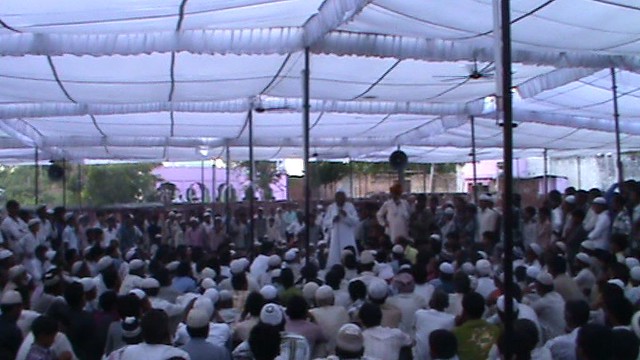
(A scene from the Jhaula relief camp. The local organizing committee of the relief camp is considering a proposal from some villagers of Kheda Mastan asking Muslims from the village to return back. The proposal was turned down.)
One riot victim we spoke to at the Jhaula relief camp narrated how villagers from her own village, and not outsiders had turned against them. She along with all the women of her family were holed up within the village when the rioting took place and were unable to leave. Two days into the violence their family members who had managed to escape to the Jhaula relief camp went back to Lakh with the Army and rescued them. When asked if she would consider returning to her village she categorically refused. Given that Muslim victims have chosen other villages with a substantial Muslim population, and with prospects of returning to their villages a process of forced ghettoization is under way.
Economic class dimension of the riots:
In many areas the caste-religious divisions between the two communities overlap with class division. The riots in Muzaffarnagar are unprecedented in the rural spread of the riots, where the displaced will not be able to return to their lands, however meager. These lands now stand to be taken over by the socially and economically dominant sections within the villages. All signs of economic independence and prosperity were vandalized. Among the various reasons riot victims in relief camps are turning down all offers of returning to the villages is the suspicion that they are required immediately to attend to the standing sugarcane crop in the fields. Despite loss of livelihood victims in relief camps have refused to return to their villages
Conclusion: JNUSU’s demands
The JNUSU demands that the Prevention of Communal and Targeted Violence (Access to Justice and Reparations) Bill 2011 be tabled in parliament. While some provisions of the bill such as its implications for India’s federal arrangement need to be discussed, the Bill makes important recommendations. All acts of omission on the part of the local police or the administration would be considered as acts of commission and will be punishable as such. In this case it would mean that the DMs inaction in stopping the violence in Sakheda and at Basee would be culpable offences. Also the police inquiry into the killings at Kawaal and Basee should be made public so that politically motivated rumors are scotched immediately. The JNUSU fact finding team raised this issue with the SSP Muzaffarnagar Praveen Kumar, who informed us that the investigation into the Kawaal killings will be concluded soon.
The JNUSU demands that the practice of mixed police stations be immediately restarted. Also command responsibility for any act of omission or commission during riots must be shared through the chain of command including the home minister.
The JNUSU also demands that the Transfer Raj now in place within which Police Officers and Magistrates are shunted out at will be reconsidered and appropriate safeguards be maintained to avoid political interference with administrative functiononing.

